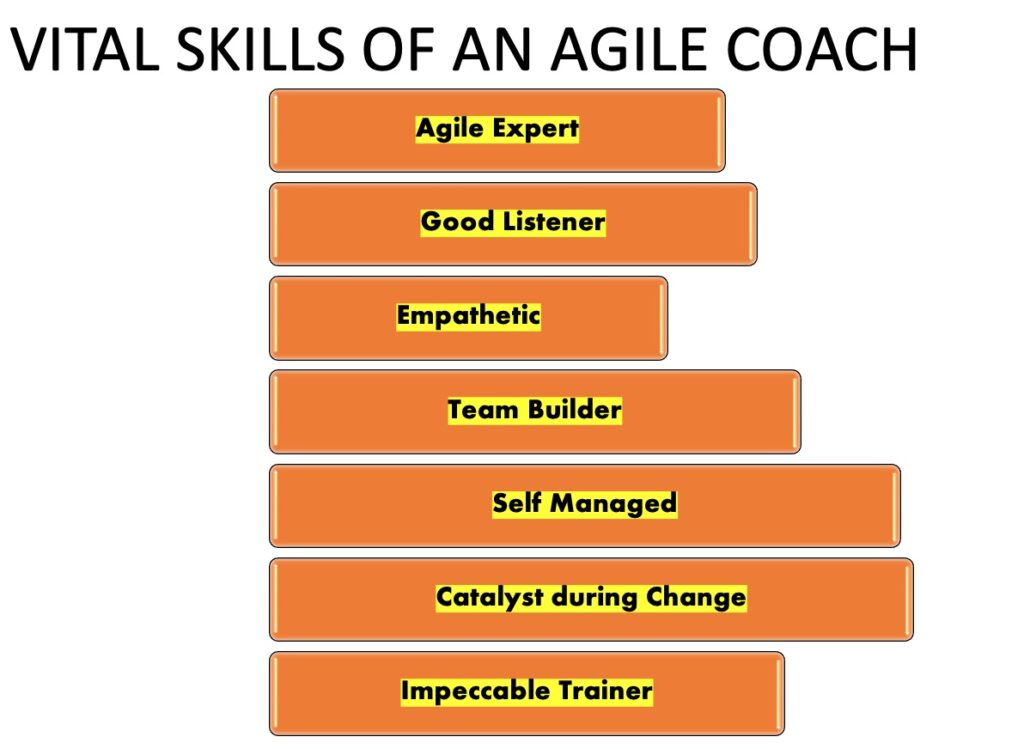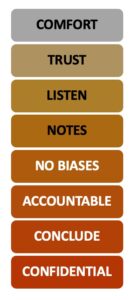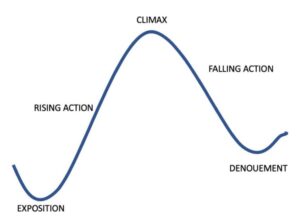We all need to know what agile coaching is as it is the responsibility of everyone to know agile practices processes and contribute towards change.
Table Of Contents:
- Agile Coaching
- Agile Coaches
- Vital Skills of an Agile Coach
- One-on-One Coaching Conversations
- Roles and Responsibilities of an Agile Coach
- Conclusion
Agile Coaching #
Let us see what agile and coaching mean separately to understand what agile coaching is.

Agile is a philosophy to follow for continuous improvement. Agile is an approach in which teams work iteratively to deliver faster, valued, high-quality products to their customers. Agility brings people to come to a common understanding.
Coaching is a process where an experienced person helps individuals improve their performance and evolve continuously.
Agile coaching is a process to help people and organizations to rise from where they are now to where they want to be. Agile coaching is the art of conversing with a coachee and guiding them with different perspectives by sharing experiences based on what you learned from others and who you are.
“I would say that agile coaching is 40% doing and 60% being”
— Lyssa Adkins.
“Coaching is a method for helping others to improve, develop, learn new skills, find personal success, achieve aims and manage life change and personal challenges”
— Laura Whitworth.
Agile Coaches #
Agile coaches are agile experts who help people, teams, and organizations perform better and grow. An agile coach sometimes needs to wear the teacher’s hat and sometimes be a mentor to help organizations and people know what agile is and adopt it.
An Agile coach acts as a facilitator in an organisation’s agile journey by helping people identify and solve their problems.
Vital Skills of an Agile Coach #

Agile Expert #
As an agile coach, one should understand different agile methodologies like Kanban, Scrum, Scaled Agile Framework (SAFe), Lean, etc. They should have good experience working in agile and identify how and where to implement them.
Good Listener #
An agile coach needs to be a good listener. Listening is one of the vital skills any coach should have.
Imagine talking to a person who is busy looking at something else. How would this make you feel? Not good. You may also feel disrespected or neglected.
Agile coaches should provide their complete attention while listening to their coachees’ problems. Apart from giving attention while listening, they should grasp all conservation details and process them.
As an agile coach - One should listen to what the other person is saying and understand unsaid words from noticing their behavior, such as the change of behavior when the environment changes, the body language, and facial expressions.
Empathetic #
Understanding feelings is again a fundamental skill for an agile coach. They should be able to borrow the shoes of their coaching clients, understand what they are going through, and then return those shoes without getting attached to the problem or the situation.
Team Builder #
As an agile coach, one should build trust within the teams. Also, agile coaches need to learn how to rebuild broken trust. A fundamental factor in building trust is avoiding emotional theories and sticking to facts. An agile coach should bring vulnerability to the team to learn to trust each other. The team should share all kinds of information and problems with each other. Similarly, the coaching conversations should reflect trust.
Self Managed #
Self-management is not just for an agile coach but for everyone for filling an environment with harmony. Handling emotions is required when it comes to helping the teams as an agile coach or coaching one-to-one. Below is an approach an agile coach can practice taking control of their emotions while facilitating under challenging situations without getting attached to the problems and responding after processing the provided information.

Self Management
Change Catalyst #
An agile coach should enable organizations, teams, and people to bring the best in them and facilitate essential changes.
An agile coach should be the one who speeds up the changes and thus improves organizations, teams, and people to perform better. Agile coaches don’t get involved in the change.
Impeccable Trainer #
Again, one of the very basic skills an agile coach requires is to conduct good training, impacting people. Keep a few things in mind before imparting training.

Be a Good Trainer
Time Management:
In training, time should be well-managed, start on time, and complete the selected topics on time.
Content:
_Excellent and relevant content is always valued._ The training content should be within the scope of the training. Adding lots of visuals and examples in the content makes the pieces of training exciting, and participants feel well-connected.
Use Metaphors
The trainer can use metaphors to help the participants better understand as they add life to words and vivid imagination to the subject.
Adding Humour:
Many trainers add humour while training as this does not let the participants feel bored. It helps people feel energized. Adding humour also allows the trainer to create a bond with the audience.
Activities:
Adding a lot of activities helps the participants grasp the concept and, at the same time, keeps them entertained and engaged. Adding activities provides participants with an immersive experience.
One-on-One Coaching Conversation #
The job of the agile coach is to help each member perform at their best and take steps forward in their agile journey. Therefore, often people come to an agile coach to discuss a problem, or an agile coach may approach a member if they see an issue.
The problem and the solution should come from the coaching client in such conversations.
Here are a few points that would lead to a meaningful and fruitful conversation.
- Make the coachee comfortable by greeting the coachee. Make sure that the coachee is at ease and trusts you.
- Listen to the coachee patiently and with mindfulness.
- Ask your coaching client to make notes of their takeaways.
- Discuss the problem without any biases.
- Make the coachee accountable for their actions and get clarity on timelines.
- Conclude the conversation before closing it.
- What happens in the conversation remains only with the coach and coachee. That is, the dialogue is confidential.

One-to-One Conversations
Techniques for Coaching Conversations: #
1. Powerful Questions: #
Resist asking questions with a boolean or static reply instead, ask open-ended questions. Asking open-ended questions will give the coachee the freedom and the space to respond in detail. Self-expression might let you know even the minor details.
Example:
- What made you think that way?
- How do you think I can help in this situation?
- What other issues are important to you?
2. Story Telling: #
Tell a situation-based story that helps the coachee feel more connected during the conversation. It helps to resolve problems by themselves with imagination.
One can use the below graph to frame stories.

Art of Story Telling
A coach needs to stop at the climax (twist in the story) so that the coaching client can imagine the subsequent actions and denouement (final part of the story).
3. Inquiry: #
An inquiry gathers information by asking questions and applying human senses to the data collected. A humble inquiry may provide a coach with a lot of information that helps understand the coachee’s mindset and the complexity of the problem.
Roles and Responsibilities of an Agile Coach #
TEACHING TEAMS : #
An agile coach teaches agile principles and helps teams implement agile frameworks like Scrum, Kanban, Safe, etc. Agile coaches guide the emerging teams in their agile path.
IMPARTING TRAININGS #
Everyone looks upon agile coaches as role models. An agile coach trains the teams to become independent so that organizations can move from where they are now to where they want to reach. Agile coaches also play an essential role in training the leaders such as managers, scrum masters, other executives on agility.
CHANGE FACILITATOR #
Circumstances change as the organizations, projects, people progress. Agile coaches help support the change process or may even lead the change process.
Let us discuss a few methods that help facilitate the changes:
Identify the Purpose of Changes: #
Find the root cause of why this change is required. Ask questions to find out the purpose of doing something.
Identify your Support System: #
Strengthen yourself by knowing who can be the first to help you.
Pros and Cons #
Find the pros and cons of the change and guide the teams with that knowledge.
Brainstorm #
Brainstorm ideas with the team.
Address Constraints #
Address the constraints with the team.
LEVERAGING CONFLICTS #
Conflicts are inevitable in agile teams because of people from different backgrounds.
Conflicts should be encouraged so that different perspectives come to light.
As an agile coach, one should improve the team’s performance by using the conflicts constructively. An agile coach should infer the level of conflict and help the team face it. An agile coach should not teach teams to avoid conflicts rather coach them how to convert conflicts into constructive disagreements.
CULTURAL DEVELOPMENT #
An agile coach encourages cultural development in the organization. They promote a culture of openness and trust among each other. They add a flavor of vulnerability within a team not only in work but in their personal lives as well as it is a way that makes people within the teams share more and more and, most importantly, makes them learn how to depend on each other without doubts. Such a culture builds excellent products and inspiring leaders.
CONCLUSION #
To conclude, I would say an agile coach enables people to deliver the best software and get the best out of them.